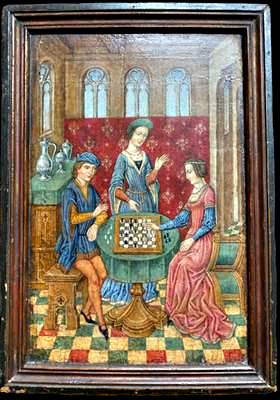The Spanish Forger Liked Chess
While I was compiling the short list for this month's edition of Top eBay Chess Items by Price (March 2010), eBay proposed other chess items under the heading 'Similar sponsored items'. I looked at several that reminded me of an old post titled, Chess Art, Chinese Copies (July 2010).
The item pictured below was titled, 'The Spanish Forger - museum piece old master oil panel - medieval chess players'. It sold for US $2725 after a single bid. Before I get into the details of the piece sold at auction, I'll mention a couple of references for the question, 'What's the difference between a forgery and a copy?':-
- Fakes vs copies (deccanherald.com; 'Vienna : Museum of Art Fakes') • 'Copy: A copy of an existing work without the reference that it is original. [...] Fake/forgery: A copy of an existing work with the wrong reference it is original.'
- Why forgeries, fakes and counterfeits aren’t the same thing (gbgplc.com; 'We are GBG, global specialists in digital identity.') • 'On the face of it, forgery and counterfeit are synonyms for fake -- but they're not actually the same thing, especially when you’re talking about falsified identity documents. [...] 1. Forgery: a genuine document that has been unlawfully altered; 2. Counterfeit: a copy of a genuine document; 3. Fake: an identity document that isn't officially produced or recognised'
I knew that intuitively, but it's always a good idea to get confirmation from an expert. Here's a copy of the item sold via eBay.

The description said,
A beautiful antique oil painting, depicting "The Chess Players" By the Spanish Forger. Two other paintings with chess players by the Spanish Forger are known, both are in museum collections. • Univ. of Pennsylvania, LJS MS 33 • NY, Columbia Univ., Plimpton Add. MS 18
Those last two 'MS' references are for the two other chess paintings by the Spanish Forger, easily found using the obvious keywords. The description incorporated a *copy* (attributed!) to Spanish Forger (wikipedia.org). The Wikipedia page starts,
The Spanish Forger (French: Le Faussaire espagnol) is the name given to an unidentified individual who, in the late 19th to early 20th century, created a large number of forgeries of medieval miniatures.
The eBay text copied from Wikipedia was followed by more details about the piece.
Origin: France • Provenance: Private Collection (Paris, France) • Age: 19th century (Buy with confidence, 100 % money back guaranty!) • Signature: The Spanish forger never signed his work • Material: Oil on panel • Measurements: Approx 14 X 9.8 inch wide tall (35 X 25 cm) • Condition: Good, little signs of age but not disturbing, and I guarantee that the painting is stable; there is absolutly no wood worm inside.
Best takeaway from this post? For me, it's the existence of the 'Vienna Museum of Art Fakes': a whole museum just for fakes.




No comments:
Post a Comment